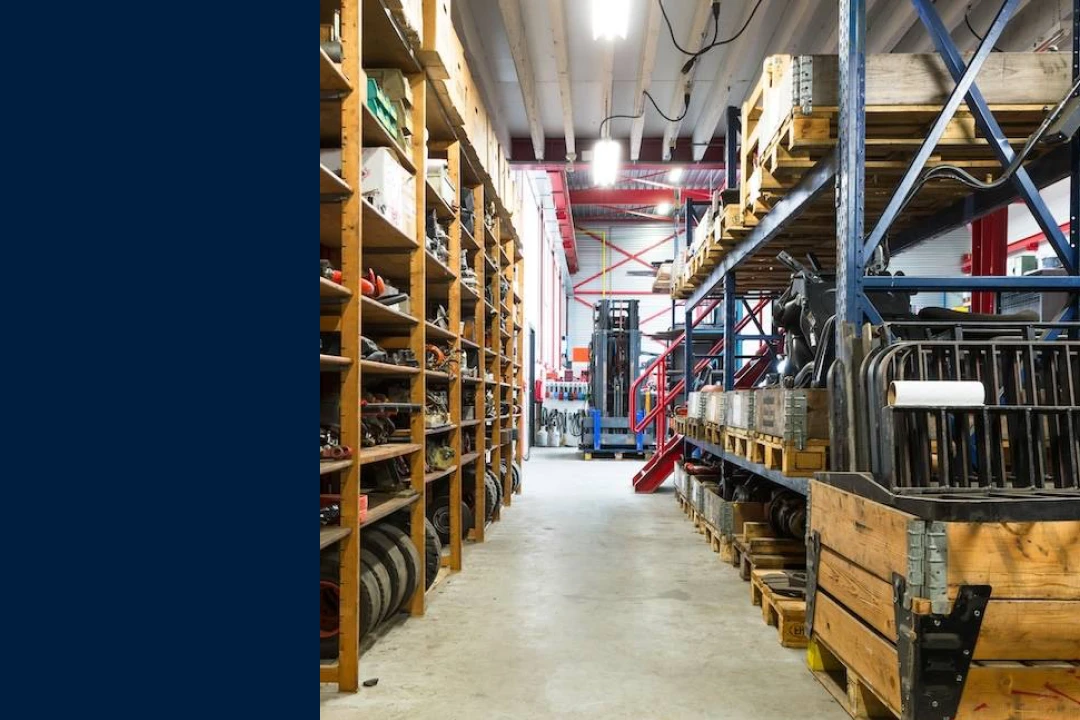
Every hour of downtime can cost thousands.
Yet the part that prevents downtime might be sitting in a warehouse halfway around the world, delayed by shipping bottlenecks or supply shortages.
Smart spare parts management has become one of the most effective defenses against unplanned downtime and runaway maintenance expenses, especially in a volatile economic landscape. Since parts replacement still represents a major share of equipment lifecycle costs, a real mastery of inventory management is no longer just a “nice-to-have.”
In this article, you’ll learn how to categorize spare parts by value and criticality, and discover how modern software platforms empower teams to predict demand, reduce waste, and coordinate operations seamlessly across multiple sites.
Key takeaways
- A proactive maintenance strategy is the foundation of effective spare parts management, allowing you to forecast needs rather than react to failures.
- Categorizing parts by consumption value (ABC analysis) and criticality (Vital, Essential, Desirable analysis) helps you prioritize which items to stock, optimizing both cost and availability.
- Using a Computerized Maintenance Management System (CMMS) like MaintainX to track parts usage, automate reorder point alerts, and manage vendor information is essential for reducing manual errors and preventing stockouts.
- Accurately calculating lead times and asset risk ensures you have critical spares on hand for high-value equipment, reducing the financial impact of unplanned downtime.
Introduction to running spare part inventory programs
What is spare part inventory?
Spare part inventory refers to a list of stock items that maintenance technicians use to replace failed equipment parts. Manufacturing facilities keep spare part supplies (like belts, motors, gears, and grease) on hand so they can fix equipment failures in minutes as opposed to days, weeks, or months.
However, spare part inventory also includes small items like printer cartridges, batteries, and light bulbs. Maintenance departments or general operational departments typically store spare parts in stockrooms on location.
Before we move on, let's address a common source of confusion: do the terms stock parts and spare parts refer to the same thing?
The difference between a spare part and a stock part
A spare part refers to an extra part of a machine kept for replacement or use in an emergency. Notably, businesses use spare parts solely for maintenance and repair.
A stock part refers to items kept to produce deliverables for sale. In other words, stock parts eventually leave facilities in the form of finished products.
In addition to product materials, stock parts include personal protective equipment (PPE), packaging materials, and office supplies. While spare parts depend on maintenance activities, stock parts are contingent on planned production output.
Benefits of spare parts inventory
Unfortunately, feeling torn between minimizing operating costs and keeping plentiful inventory items on hand is normal.
When facing pressure from upper management to increase bottom lines, maintenance managers sometimes keep inventory levels low across the board. But this approach leads to significant operational risks.
When spare parts aren't available, the financial losses pile up fast: equipment downtime, missed production targets, rushed shipping costs, and unhappy customers. Following inventory management best practices yields several benefits:
- Quick responses to emergency repairs: No matter how intensive a preventive maintenance program you run, unplanned downtime is inevitable. Organizations must prioritize having spare parts for critical machinery on hand. The quicker maintenance technicians restore functionality, the fewer losses from equipment downtime.
- Improved maintenance metrics: Having critical replacement parts reduces employee idle time and improves wrench time assessments. This directly impacts your department's overall efficiency ratings.
- Reduced repeat repairs: Sufficient stock levels help you "do it right" the first time instead of performing temporary patch jobs that require future work orders.
- Lower operational expenses: Effective spare parts management eliminates rushed shipping costs, stalled production, and worker idle time while preventing catastrophic downtime costs.
You'll also see better equipment uptime, clearer part visibility, and stronger brand reputation. Here's how to build a spare parts system that actually works.
How to categorize and organize spare parts inventory
An effective spare parts inventory program starts with organization. Without a logical system, your storeroom becomes a source of waste and inefficiency. A systematic approach to categorization ensures technicians find the right part quickly and helps you make data-driven decisions about stock levels.
Two of the most effective methods for industrial inventory categorization are ABC analysis and Vital, Essential, Desirable (VED) analysis.
- ABC Analysis: This method classifies parts based on their annual consumption value. 'A' items are high-value parts accounting for a large budget portion but few in number. 'B' items are moderate in both value and quantity. 'C' items are low-value but high-quantity parts.
- VED Analysis: This categorizes parts by operational criticality. 'V' (Vital) parts would cause immediate production stoppage if unavailable. 'E' (Essential) parts cause temporary disruption. 'D' (Desirable) parts have minimal immediate impact on production.
Creating a priority matrix for spare parts
Combining ABC and VED analysis creates a priority matrix for spare parts inventory management:
- Highest Priority: 'A' (high-value) + 'V' (vital) parts - like main drive motors for production lines
- Medium Priority: 'B' (moderate-value) + 'E' (essential) parts - such as conveyor belts and sensors
- Lower Priority: 'C' (low-value) + 'D' (desirable) parts - including standard fasteners and light bulbs
A CMMS automatically tracks this data, making it easier to apply these principles across your entire inventory and multiple facilities.
Maintaining a spare parts inventory management program
Here are six steps to optimizing inventory accuracy while keeping costs low:
Step 1: Embrace proactive maintenance
First, if you haven't already, transition your organization from an overall reactive maintenance strategy to a proactive maintenance strategy. It's not possible to completely eliminate reactive maintenance—manufacturers don't make machines to last forever.
But reactive maintenance shouldn't make up the majority of your maintenance tasks if you seek financial optimization. The success of your spare part inventory management program depends on your ability to prevent problems before they happen.
Step 2: Develop standard operating procedures
Standard Operating Procedures (SOPs) help ensure workers know exactly how to repair assets according to company standards. As a maintenance manager, it's your job to identify the most efficient way to fix standard equipment issues and maintain critical machinery.
Digital SOP checklists partner well with inventory control systems, making it easier to track when spare parts move from the stockroom to the shop floor.
We recommend using a mobile-accessible CMMS that includes parts inventory software capabilities. The best platforms allow maintenance technicians to catalog exactly what parts they are using to fulfill assigned work orders in real time.
Step 3: Adopt proper inventory control measures
Your spare parts inventory management program doesn't have to be all-inclusive to be effective. As a manager, your goal is to stock the parts most essential to operations while controlling costs.
That means updating records whenever you take parts out of the stockroom and logging new purchase orders. Clearly define and categorize all spare parts according to their manufacturers, costs, and dates of purchase.
Regularly review your inventory to check for parts due to expire or excess stock. User-friendly spare parts inventory management software helps simplify this process.
Step 4: Understand your lead times
Get a clear understanding of lead times for ordering and receiving different parts. For example, a maintenance manager at a food processing facility might find that specialized pump seals have six-week lead times, while standard bearings arrive within days.
Prioritize spare parts for critical assets over non-critical assets. Order parts with long lead times—those that take longer to ship and incur extra costs for expedited delivery—first.
5: Calculate risk
Any realistic maintenance manager will admit that it's impossible to avoid asset failures altogether. But you can calculate the risk of downtime for each asset and adequately stock up for those that are high risk.
One of the most accurate ways to assess risk is to conduct a Failure Mode and Effects Analysis (FMEA)—a systematic method for identifying potential equipment failures and their impact on operations.
Step 6: Enforce security measures
Limit access to your spare parts inventory store. Only authorized personnel should have access to the warehouse. This way, you can monitor and track spare parts moving in and out.
Also, train your team on properly receiving purchase orders and counting incoming inventory. This reduces inaccuracies that contribute to a false sense of security when you're running low down the line.
Use MaintainX spare part inventory management software
If you haven't been paying attention to your spare parts, now is the time to start. Supply chain disruptions have shown that competitive companies can't ignore spare parts inventory management anymore.
Spare parts inventory software simplifies maintenance management from one central hub. Here's what CMMS inventory management software gets you:
- Automated low-quantity alerts: The system automatically notifies teams when stock levels reach predefined minimums, saving time and preventing stockouts.
- Digital reporting: The platform generates analytics reports that reveal asset breakdown patterns and consumption trends.
- Connected workforce capabilities: Teams can manage multiple remote locations through a single dashboard, enabling visibility across all facilities.
- Vendor data management: The system centralizes supplier contact information and purchase history for quick access.
- Asset data management: Users catalog barcodes, serial numbers, and specifications for comprehensive tracking.
- Digital checklists: Standardized procedures reduce worker errors and ensure consistent part usage documentation.
- Timestamps: The system creates digital audit trails that provide proof of compliance and usage history.
The final word on spare parts inventory management
Smart spare parts inventory management combines solid planning, clear organization, and the right technology. By shifting to proactive maintenance, categorizing parts systematically, and using clear procedures, you significantly reduce costs and prevent operational disruptions.
MaintainX’s mobile platform helps frontline teams manage spare parts inventory better, cutting out the manual work that slows down productivity in equipment-heavy industries. When your technicians can track parts, monitor usage, and trigger reorders from mobile devices, you create the smooth operations that keep you ahead of competitors.
Ready to modernize your spare parts inventory management strategy? Book a tour and learn how 12,000+ organizations are already getting results with MaintainX.
FAQs on spare parts inventory management
What are the different types of inventory in manufacturing facilities?
In a manufacturing context, inventory is divided into four main categories: raw materials (components for production), work-in-progress (partially finished goods), finished goods (products ready for sale), and maintenance, repair, and operations (MRO) inventory. Spare parts fall under the MRO category, which includes all items necessary to keep equipment and facilities running but are not part of the final product.
How do maintenance teams calculate optimal spare parts stock levels?
Maintenance teams use reorder points, safety stock calculations, and economic order quantity (EOQ) formulas to determine optimal levels. A reorder point triggers new purchases when stock hits minimum levels, while safety stock buffers against unexpected demand. Modern CMMS software automatically tracks usage history and lead times to recommend optimal stock levels.
What's the difference between spare parts and consumables in industrial maintenance?
Spare parts are specific components intended to replace a failed part on particular equipment, such as a motor for a conveyor belt. Maintenance teams can often repair them and track them as individual assets. Consumables are items that maintenance teams use up during activities and don't tie to specific assets (such as grease, cleaning supplies, or disposable gloves). While both are part of MRO inventory, spare parts typically have higher value and require more stringent tracking.
How do you create an effective spare parts list for manufacturing equipment?
To create an effective spare parts list, start with the equipment manufacturer's recommendations. Next, review your maintenance history in your CMMS to identify which parts fail most frequently. Finally, conduct a criticality analysis (like FMEA or VED) to determine which parts are essential for preventing downtime. This combined approach ensures you stock the parts you’re most likely to need for your most important assets.









